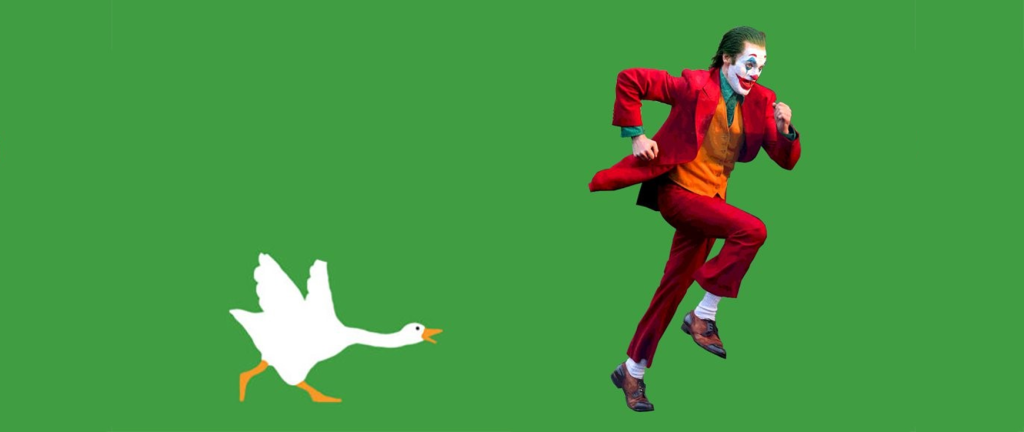
Warning; Spoilers for ‘Joker’ and ‘Untitled Goose Game’
There were two significant releases in entertainment recently. The first was the movie ‘Joker’, a bleak take on DC Comics’ darkest villain, re-imagined as a downtrodden, mentally-ill byproduct of a decaying city and a disinterested upper class. The second was ‘Untitled Goose Game’, a video game in which you pester the residents of a quaint English village as an annoying goose. Believe it or not, ‘Joker’ and ‘Untitled Goose Game’ share a lot of similarities. First, they’re both about two hours long. Secondly, they both received mixed to positive reviews. And lastly, they both feature the exact same main character, and are in fact two interpretations of the same story.
I’m not kidding.
Let’s start with the locations each story takes place in. ‘Joker’s Gotham is a city seemingly on the verge of destruction, where the people with the power to help, ignore its extensive problems. Crime is on the rise and vital services have their funding cut. Talk-shows make fun of struggling workers. And the powerful ignore the damage done to their home until some of their wealthy brethren get caught in the crossfire. It’s a city that embodies the movies tagline “smile and put on a happy face”. While the city burns, the rich just smile and pretend everything is fine.
On the surface, it doesn’t look like ‘Untitled Goose Game’s’ adorable English village shares any similarities to the streets of Gotham. The village is bright and colourful. Residents contently go about their Sunday routines of gardening, reading and visiting the pub, and there’s barely any sound or music to interrupt the calm. But in fact, the village is also putting on a “happy face”. The villagers will try to ignore any hiccup in their routines, only going so far as to retrieve any items you steal from them. There’s an undercurrent of stress and rage, and all that’s needed to reveal it, is a little bit of chaos.
That’s where our main characters come in. While the movie spends most of its time developing Joker as a character, it concludes with him coming out of his clownly closet, becoming the chaotic symbol that Gotham’s working class need. He fans the flames by killing three Wayne Enterprises employees, which leads to the poor donning clown masks and rioting. Joker kills the saccharine talk show host he used to idolise live on air, destroying the image of Gotham’s false prosperity and allowing the downtrodden to take centre stage. The so-called order that Gotham had maintained crumbles, and allows chaos to take over.
It seems silly to compare such a serious situation to a quiet village with a bird problem, but the goose does have a similar effect. The entire premise of the game is to annoy the villagers in as many fun and sadistically charming ways as possible, and the joy comes from seeing their days ruined. These people that tower over you, run faster than you, and are stronger than you, can be made miserable simply by causing a little chaos. A highlight is when you take a lady’s priceless vase into her neighbour’s garden who then throws it over the fence and smashes it. In return you vandalise the lady’s hedge, so she trims it and accidentally cuts the head off his prize rose. What started as a peaceful day of reading and painting turned into a full-blown feud, all because a goose moved a vase and disrupted a hedge. But the goose wasn’t the cause, just the catalyst. That tension was always there, it just needed to be released.
But you might be thinking, the Joker was oppressed and beaten down by the wealthy; how does that compare to a mischievous goose? Well, the goose isn’t as one-note as you might think. It has desires outside of the player’s innate need to cause trouble. The last task on your to-do list is to bring a golden bell from the model village all the way back to the goose’s nest you started in. You arrive to find a pile of golden bells that the goose had collected previously. That’s all the goose wanted; a new entry to its humble collection. This whole time, it had one sole desire, and had to fight through a battalion of powerful, entitled villagers to get it, simply because they didn’t want their precious peace disturbed. The village is the crumbling city. The villagers are the wealthy elite. The goose is the Joker.
If you’re still not convinced, I have one final, damning piece of evidence for you. When you think of the Joker, what’s one of the first things you think of? It’s the laugh. One of the reasons the character has lasted in fiction for eighty years is the fact that in the face of extreme malice and sadism, the Joker laughs. To him, everything is a joke and everything is funny. When someone new plays the Joker, one of the first questions we have is always “what does the laugh sound like?” Within the context of the new film, it’s not something the Joker can help. He has a condition that makes him laugh uncontrollably, even in incredibly stressful situations, and by the end of the film, he’s learned to fully embrace that laughter. And while the goose can’t laugh, Untitled Goose Game gives the player another, equally satisfying option.
To honk.
Some of the greatest laughs to be had in the game come from honking at the villagers, from watching them jump and flounder around as you spam the Y button. When you successfully cause the gardener to hit his thumb with a hammer, or drop a bucket on the pub landlords head, you’re compelled to honk with joy at the result of your mischief, and the misfortune of your target. Like the Joker, you can’t help but laugh. You can’t help but honk.
